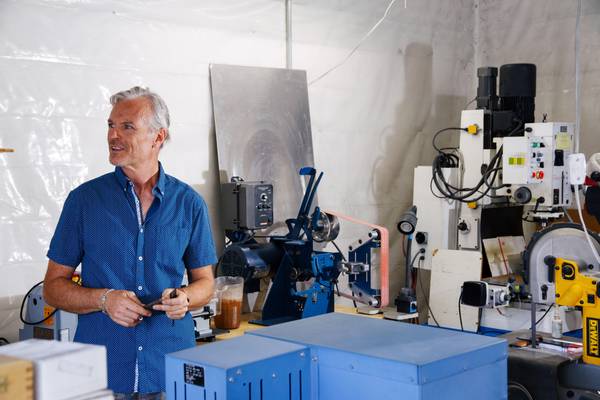Call him old-school, but Las Vegas resident Max Sprecher insists that men shaving with modern five-blade disposable razors and Barbasol cream are missing out on a sacred experience. Born in Antwerp, Belgium, Sprecher has been crafting and sharpening single-blade razors in Las Vegas for more than 10 years to promote a time-honored tradition of making shaving one’s face “a ritual.”
Tips for wet shaving
1. Pre-shave prep: Before picking up a straight razor, users should hold hot towels to their face for three to four minutes to prepare for the shave.
2. Lathering: Create a rich lather using a shave brush made of badger hair or synthetic materials and specialized shaving soaps. Users should spread the lather across their face before shaving.
3. Shaving: Apply little pressure and let the blade do the work. Begin by shaving with the grain of facial hair and skin, and, when experienced enough, eventually try shaving cross-grain and against the grain. When shaving, always remember to use light pressure. The sharpness of the blade should provide a close shave.
4. Nourishing: Once finished, rinse with cold water and use an aftershave product to soothe the skin.
“You have to incorporate that ‘me’ time in your life,” he said. “Women have their makeup, their hair, their nails, but men, we don’t really have anything like that hygiene-wise. Shaving should be a 15- to 30-minute Zen ritual, not a five-minute thing.”
A walk into Sprecher’s garage workshop in the southwest Valley paints a picture of the pure craftsmanship that takes place there on a daily basis. Thousands of dollars’ worth of machinery—affecting everything from the way a razor is milled to the way it’s heated, dried and honed—is organized across several work desks, while a deep-frying machine with industrial grade oil quenches the steel without sacrificing its hardness. Sprecher’s razors begin as rectangular chunks of stainless steel and need forging, heat treatment, quenching, tempering and grinding before they’re honed into shave-ready blades.
Sprecher, who grew up working as a silversmith under his late father, also became proficient in cleaving diamonds and cutting jewelry. In addition to making straight razors, Sprecher customizes the handles for each of the blades, selling the final products for $400 to $1,000 (for more info, visit maxsprecher.com). He says his blades are a work of art and trusts only about a dozen other such blade makers around the world to produce similar quality.
The art of creating straight razors took more than five years for him to perfect, Sprecher said, despite his decades of previous work with alloy metals. A frequent user and commenter on the online shaving forum Straight Razor Palace, Sprecher provided shaving advice and even sharpened other site users’ razors as a hobby before making his passion a full-time business. As demand for his services skyrocketed, he started charging customers to keep up with costs of adding more equipment and machinery.
“People would break things, and I’d tell them to ship it to me,” Sprecher said. “I started with woodscales, and more people were saying, ‘Your work is great,’ and shipping me more items. At first we were just doing trade. They’d say, ‘What do I owe you?’ and I’d say, ‘Oh you know, a bottle of bourbon or whatever,’ but then I started getting more work, and I had to get more equipment.”
While the wet-shaving resurgence of this decade has seen more men revert back to straight razor and classic soap-shaving from the five-blade plastic disposable razor and “shave goo” model, Sprecher said fly-by-night smiths and even knife makers have tried to make a splash in the razor design and sharpening industry. Some sellers, looking for a quick buck, have gone as far as replicating the name of Sprecher’s blades on their own models, despite the names not being “anything official.”
But Sprecher says his art is very specialized. Even a professional in the knife-making industry, when attempting to sharpen a straight razor, will ruin the blade, he said. Sprecher regularly receives shipments from clients whose razors are no longer able to be sharpened because a knife sharpening or fly-by-night razor-sharpening business has already destroyed the blade.
“Knife makers have a way of heat-treating steel that goes very high in the hardness,” he explained, “which is not what you want with a straight razor. Then they also use different angles, and the geometry is different.”
Wet shaving isn’t just about straight razors, either. For the perfect shave, Sprecher also uses a variety of shaving soaps, which cost between $40 and $100 per 4-ounce puck, and brushes made of badger hair to apply the soap, which are valued at more than $200. More affordable, synthetic brushes have since made their way into the market and can be bought at a fraction of the price, Sprecher said.
Sprecher, whose working career also included nearly two decades as an international fashion model, said wet shaving is a time-honored tradition that “has always been and is here to stay,” thanks to the quality experience it provides those who practice it. But for consumers looking for both the best in professionals and products in the wet-shaving industry, Sprecher said to always use caution and do business only with reputable sources.
“If it looks too good to be true, don’t trust it,” he said.
This story originally appeared in the Las Vegas Weekly.

